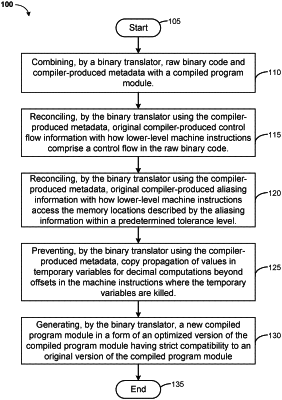| CPC G06F 8/443 (2013.01) [G06F 8/447 (2013.01)] | 20 Claims |

|
1. A computer-implemented method for binary translation, the computer-implemented method comprising:
combining, by a binary translator, raw binary code and compiler-produced metadata associated with a compiled program module;
reconciling, by the binary translator using the compiler-produced metadata, original compiler-produced control flow information with how lower-level machine instructions comprise a control flow in the raw binary code;
reconciling, by the binary translator using the compiler-produced metadata, original compiler-produced aliasing information with how lower-level machine instructions access the memory locations described by the aliasing information according to predetermined criteria;
preventing, by the binary translator using the compiler-produced metadata, copy propagation of values in temporary variables for decimal computations beyond offsets in the machine instructions where the temporary variables are killed;
removing, by the binary translator using the compiler-produced metadata, of identified dead store instructions; and
generating, by the binary translator, a new compiled program module in a form of an optimized version of the compiled program module having strict compatibility to an original version of the compiled program module.
|